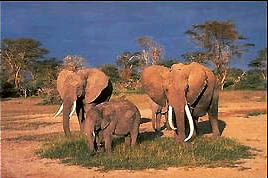
Such emotional activism on behalf of elephants is understandable. But whether PETA’s activism goes beyond rhetoric to achieve results—like more elephant habitat and more elephants—is another matter. Unfortunately, environmental groups such as PETA are too often long on rhetoric and short on results.
Like many environmental groups, PETA is all about the “anti.” In this case, it is anti-hunting. Its supporters rally against causes with easily identifiable “bad guys” such as corporations and hunters like Bob Parsons. While such good-versus-evil narratives are useful for garnering financial support, they ignore the complexity of human-wildlife conflicts in Africa and the role of property rights and local management in resource conservation.
Seldom does PETA advocate for more practical but less emotive “pro” causes such as wildlife habitat, community resource management, or higher incomes. As a result, it neglects solutions such as devolving wildlife management to the local level, where the people living with the costs of wildlife can find ways to profit from sustaining the habitat and the animals. Where property rights to wildlife have been assigned to local communities—either through explicit institutional reforms or innovative entrepreneurship—Africans have proven that private ownership means resources stewardship.
Parsons’ hunt epitomizes results rather than rhetoric and shows how active conservationists can help both people and wildlife. In Parsons’ words, “This farmer was desperate. He couldn’t get the herd out of his field. He asked us to come and deal with it.” Parsons’ video, albeit distasteful at times, reveals the cold reality of conservation in Africa. Wildlife imposes real costs on the nearby communities. Achieving results means involving these communities in wildlife management and providing them the right incentives to protect wildlife and its habitat.
PETA’s anti-hunting rhetoric fails on both counts. Anti-hunting groups succeeded in getting Kenya to ban all hunting in 1977. Since then, its population of large wild animals has declined between 60 and 70 percent. The country’s elephant population declined from 167,000 in 1973 to just 16,000 in 1989. Poaching took its toll on elephants because of their damage to both cropland and people. Today Kenya wildlife officials boast a doubling of the country’s elephant population to 32,000, but nearly all are in protected national parks where poaching can be controlled. With only 8 percent of its land set aside as protected areas, it is no wonder that wildlife in general and elephants in particular have trouble finding hospitable habitat.
For the landowners who bear the costs of wildlife, the decision of whether to protect wildlife is a simple one: if it pays, it stays. The ban on hunting gives wildlife little or no economic value, causing rural Africans to view wildlife as a liability to be avoided rather than an asset to be protected. As a result, landowners have increasingly turned to agriculture instead of habitat protection, which decreases available habitat and increases the potential for human-wildlife conflicts.
In sharp contrast to Kenya, consider what has happened in Zimbabwe. In 1989, results-oriented groups such as the World Wildlife Fund helped implement a program known as the Communal Areas Management Programme for Indigenous Resources or CAMPFIRE. This approach devolves the rights to benefit from, dispose of, and manage natural resources to the local level, including the right to allow safari hunting. Community leaders with local knowledge about wildlife and its interface with humans help establish sustainable hunting quotas. Hunting then provides jobs for community members, compensation for crop and property damage, revenue to build schools, clinics, and water wells, and meat for villagers—just as Parsons’ elephant did.
By granting local people control over wildlife resources, their incentive to protect it has strengthened. As a result, poaching has been contained and human-wildlife conflicts have been reduced. While challenges remain, especially from the current political climate in Zimbabwe, CAMPFIRE has quietly produced results with strikingly little activist rhetoric.
The numbers attest to the program’s success. Ten years after the program began, wildlife populations had increased by 50 percent. By 2003, elephant numbers had doubled from 4,000 to 8,000. The gains have not just been for wildlife, however. Between 1989 and 2001, CAMPFIRE generated more than $20 million in direct income, the vast majority of which came from hunting. During that period, the program benefitted an estimated 90,000 households and had a total economic impact of $100 million.
The results go beyond the CAMPFIRE areas. Between 1989 and 2005, Zimbabwe’s total elephant population more than doubled from 37,000 to 85,000, with half living outside of national parks. Today, some put the number as high as 100,000, even with trophy hunters such as Parsons around. All of this has occurred with an economy in shambles, regime uncertainty, and mounting socio-political challenges.
Throughout southern Africa, hunting and wildlife-related tourism have spurred private sector investment in wildlife conservation. The region is now home to more than 9,000 private game ranches, 1,100 privately managed nature reserves, and over 400 conservancies. In Namibia, which allows hunting, more than 80 percent of all large wild mammals live on private and community lands, and those populations have increased by 70 percent in recent years. In these regions where wildlife pays its way, habitat is conserved and wildlife populations thrive.
Such success has caused some in Kenya to advocate a possible change in its wildlife laws to allow “sustainable use” of wildlife on private lands. So far, the efforts have been unsuccessful—in large part due to the rhetoric of international animal rights activists. Animal-rights groups are influential in Kenya, often providing resources for the cash-strapped Kenyan Wildlife Service. But unlike private landowners, they do not pay for the impact of wildlife on land and people. As a result, they overlook a fact that Zimbabwe and other African nations have already discovered: wildlife in Africa needs economic value to survive.
PETA and others dispute the claim that hunting helps farmers in Africa whose crops are damaged by animals. PETA argues that preferable alternatives exist. In a response to Bob Parsons’ hunt, for example, PETA wrote that “there are ample effective and nonlethal methods to deter elephants from crops, including using chili-infused string and beehives on top of poles to create low-cost ‘fences’.” Other non-hunting tactics include planting crops which elephants do not like to eat or burning “chili bombs” made of elephant dung infused with chili pepper. The problem is that most wildlife, including elephants, becomes immune to such tactics. Moreover, a 2008 World Wildlife Fund report on human-wildlife conflicts in Namibia found that such methods have not been proven effective because they are time consuming and require regular supplies and maintenance.
The same report concludes that under community-based natural resource management, such as CAMPFIRE in Zimbabwe and similar programs in Namibia, wildlife is able to provide economic benefits that exceed the costs of human-wildlife conflicts. By devolving property rights to wildlife to the local level, these programs allow communities to internalize both the costs and benefits from wildlife. The farmers who requested Parsons’ help not only culled the problem elephant, they got income, jobs, and meat from his hunt. That is results, not just rhetoric.
If environmental organizations want to produce more results, they need to put aside their obsession with issues such as hunting and advocate on behalf of property rights and community resource management. This allows the decisions over wildlife and other natural resources to be made by the people who bear its costs. The experience of Zimbabwe, Namibia, and other southern African countries that have harnessed the power of local control suggests that this approach can benefit both people and wildlife in Africa.
Organization such as PETA, the International Fund for Animal Welfare, Earthjustice, and Greenpeace are but a few well-funded groups whose boycotts, protest marches, and letter-writing campaigns produce lots of rhetoric but few results. In contrast, hunting organizations such as Safari Club International or environmental groups such as the Environmental Defense Fund, whose motto is “finding the ways that work,” get a real bang for their buck. PETA’s rhetoric may take the moral high ground, but Parsons’ hunting is putting more elephants on the earth.
The next time you write a check to your favorite environmental group, ask whether you are buying environmental rhetoric or environmental results.


